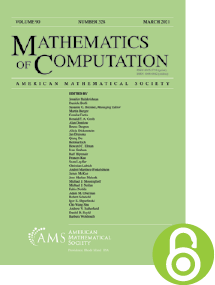Additive methods for the numerical solution of ordinary differential equations
HTML articles powered by AMS MathViewer
- by G. J. Cooper and A. Sayfy PDF
- Math. Comp. 35 (1980), 1159-1172 Request permission
Abstract:
Consider a system of differential equations $x\prime = f(x)$. Most methods for the numerical solution of such a system may be characterized by a pair of matrices (A, B) and make no special use of any structure inherent in the system. In this article, methods which are characterized by a triple of matrices $(A;{B_1},{B_2})$ are considered. These methods are applied in an additive fashion to a decomposition $f = {f_1} + {f_2}$ and some methods have pronounced advantages when one term of the decomposition is linear. This article obtains algebraic conditions which give the order of convergence of such methods. Some simple examples are displayed.References
- J. C. Butcher, On the convergence of numerical solutions to ordinary differential equations, Math. Comp. 20 (1966), 1–10. MR 189251, DOI 10.1090/S0025-5718-1966-0189251-X
- G. J. Cooper, The order of convergence of general linear methods for ordinary differential equations, SIAM J. Numer. Anal. 15 (1978), no. 4, 643–661. MR 501920, DOI 10.1137/0715043
- J. Douglas Lawson, Generalized Runge-Kutta processes for stable systems with large Lipschitz constants, SIAM J. Numer. Anal. 4 (1967), 372–380. MR 221759, DOI 10.1137/0704033
- Robert Skeel, Analysis of fixed-stepsize methods, SIAM J. Numer. Anal. 13 (1976), no. 5, 664–685. MR 428717, DOI 10.1137/0713055
Additional Information
- © Copyright 1980 American Mathematical Society
- Journal: Math. Comp. 35 (1980), 1159-1172
- MSC: Primary 65L05
- DOI: https://doi.org/10.1090/S0025-5718-1980-0583492-2
- MathSciNet review: 583492


